Large-fruited and mid-season pumpkin variety “Volzhskaya gray”: rules of agricultural technology and tips for growing
Pumpkin is the largest vegetable in the world. The warmer the climate of the area in which grow this fruit, the larger it will grow. In Central Asia, pumpkins often grow that weigh up to a couple of centners. But the crop is also grown in Russia, where, with proper planting and care, it will yield a good harvest.
The Gray Volzhskaya variety has proven itself well among vegetable growers. The main thing in growing pumpkins is to follow the rules of agricultural technology. Then all the time you can prepare many delicious dishes from pumpkin from your own garden.
Description of the variety
The fruits of Volga gray tolerate transportation well. Pumpkins are mainly grown for sale. The keeping quality of the product is high. Pumpkin retains its presentation for a long time even without special conditions. The culture is characterized as drought-resistant. In less suitable conditions, the fruits lose their taste, but the yield remains the same.
Minimal watering and high ambient temperatures are not critical for pumpkins: proper cultivation and care of it are determined by the composition of the soil and the climatic characteristics of the region where the crop is ripening.
Distinctive features
Pumpkin is grown both by seedlings and by direct sowing in the ground. Medium-sized bush: lashes spread from the main shoot to the sides. The more sunlight a plant gets, the greener the leaves become. The pubescence of the leaf plate is average.The foliage is divided into visible segments. Closer to harvest, it loses moisture and dries out.
Long lashes have an average thickness. The color of the side shoots is rich green. Closer to the stalk the color becomes darker with stripes. When bushes grow, they often intertwine with each other. With timely watering, the leaves rise above the fruits - this gives the vegetables additional protection from the scorching rays of the sun.
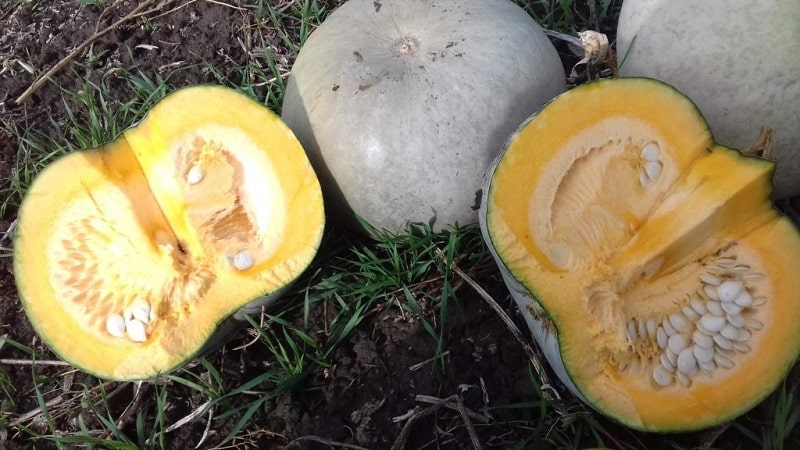
Fruit characteristics
The variety has an unusual color. The gray dense peel never turns yellow. Inside is soft and rich in taste juicy pulp. Pumpkin has high taste qualities: if the fruit has time to ripen, it does not need to rest - the pulp is ready to eat. The use of the vegetable is universal. It is consumed baked, boiled or raw.
The fruits are characterized by the following features:
- the peel is thick, elastic, without spots and ribs;
- round shape, slightly flattened on both sides;
- the division into segments is partially expressed - the larger the vegetable, the more segments;
- the thickness of the pulp is 5 cm or more, the color is yellow, and closer to harvest it becomes orange;
- The seeds are round in shape, tasty and healthy.
There is no pattern on the fruits. If you regularly water and fertilize the soil, the color of the skin will be more saturated.
Productivity
Large-fruited and mid-season crops are grown throughout Russia. From the moment of emergence of seedlings until the ripening of full-fledged fruits, 110-120 days pass. Pumpkin has good yield: The average weight of one vegetable is 9-10 kg; with good care, larger specimens grow.
How to grow
Volga Gray pumpkin thrives best on loamy soils. Sandy loam soil of low fertility will need to be well fertilized.Clay and acidic substrates are not suitable for growing this vegetable, since under conditions of limited nutrition and lack of oxygen, the roots in the fruit will form hard, thin pulp.
During the rainy season, a large amount of moisture accumulates in a low area of the garden, so if possible, it is better to plant pumpkins in elevated areas. With excessive watering, the root collar of the bushes begins to rot, and the pulp acquires a watery taste. The soil should be fertile, loose and well warmed up.
Did you know? Man has been growing pumpkins since the 5th millennium BC. e. The South American continent is considered the birthplace of this vegetable.
Planting seeds and seedlings
Many vegetable growers first grow seedlings and then transplant them to the plot. But if you decide to plant directly in the ground, do it in late spring, or for regions with cool climates, in early summer.
Planting by seeds
Soak before sowing seeds in a weak solution of potassium permanganate (1 g per 200-300 ml of water) for 30 minutes. This liquid will disinfect them and slightly soak them.
Sowing seeds correctly:
- After fertilizing the soil, moisten it slightly. Water with warm water.
- Plant 4 pre-prepared seeds in each hole to a depth of 3 cm.
- Cover the planted seeds with loose soil.
- Mulch the holes. Humus is suitable for this purpose - in combination with warm water poured onto the bed in advance, it will provide the necessary warmth.
- Cover the wells with glass or plastic to protect them from the weather. If serious frosts are not expected, remove the glass when the first shoots appear.
Most summer residents, especially in central Russia, prefer the seedling method of growing vegetables.
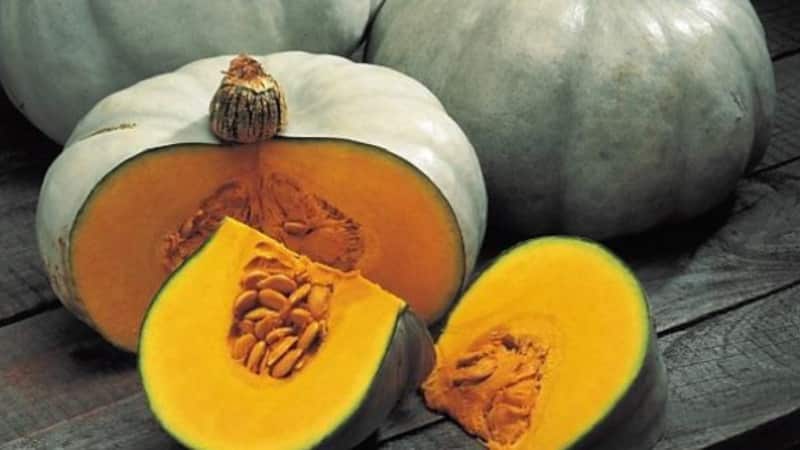
Seedling method
Wrap the seeds in damp cotton material and wait until they hatch. This will take about 10 days. Moisturize them regularly to prevent drying out. Then place the sprouted seeds in peat cups filled with a soil mixture, which should consist of turf soil, mullein, humus and peat in a ratio of 1:1:3:5.
In order for the seedlings to grow well, they need sunlight, place them on the windowsill. Maintain a temperature of 20-25 during the day and 15 degrees at night.
Be careful. At the time of planting, seedlings should have a stocky stem with internodes and developed leaves.
Plant it together with a peat container so as not to damage the root system. Over time, the container in the ground will dissolve.
Care
Before the pumpkin vines elongate, while the root collars are clearly visible, be sure to loosen the soil after heavy watering or rain to avoid cracking the soil crust. Along with loosening, carry out weeding - carefully pull out the grown weeds from the loosened soil.
On a note. During the entire growing season, about seven weedings and loosening are carried out (every two weeks).
Untimely care of the pumpkin will have a bad effect on the harvest. Carry out the first loosening to a depth of 15 cm. A month after planting, reduce the loosening depth to 8-9 cm so as not to touch the top layer of the root system.
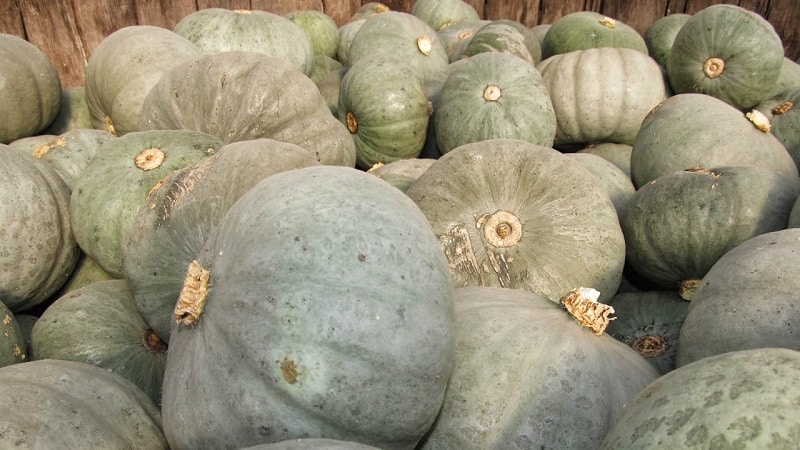
Watering
The main component of plant care is regular watering. The pumpkin, like a powerful pump, constantly takes all the water from the ground, after which it evaporates through the leaves. Therefore, the roots and stems of the plant receive a small amount of moisture, which is why regular watering is needed.
For your information. During the period of mass flowering and fruiting, water the pumpkin generously. For this, use warm water (from +22°C), it can be heated in the sun. Watering with cold water on hot days sometimes leads to the death of the plant.
Formation
The Volga Gray pumpkin needs the correct formation of the vines. To do this, pinch the central trunk. Form the plant into two stems. Position the vine so that the top is in the sun, otherwise the harvest will be small.
To grow larger fruits, form the crop into one vine. On the main stem, on each side, after four leaves, leave one shoot and remove the rest. Next, when the ovaries appear, remove all excess shoots.
Top dressing
To get large fruits, feed the Volga Gray pumpkin several times a season:
- When 3-5 leaves appear, apply mullein (0.5 liquid fertilizer must be dissolved in a 10 liter bucket of water), then water. Consumption: one bucket is enough for about five plants.
- Feed the plant a second time at the beginning of the formation of lashes, also with mullein, but with the addition of one tablespoon of nitrophoska.
- Apply the third fertilizer during fruit formation, use mullein, into which you need to add a glass of ash and two tablespoons of potassium sulfate, and water the plants with the resulting mixture.
Features of cultivation and possible difficulties
In the south, preference is given to planting seeds in an open bed. In the regions of the Middle and Central zone, this crop is grown in seedlings.
Considering pumpkin’s high need for nutrients, it can be called a capricious crop and demanding of its predecessors and neighbors.
It is best to grow this vegetable after:
- cruciferous vegetables – cabbage, radishes;
- nightshades - potatoes, tomatoes;
- onion crops;
- legume plants.
These same crops are considered favorable for planting next to pumpkins. It is not recommended to plant pumpkin after other representatives of the Pumpkin family - cucumbers, zucchini, squash, to avoid damage by common pests.
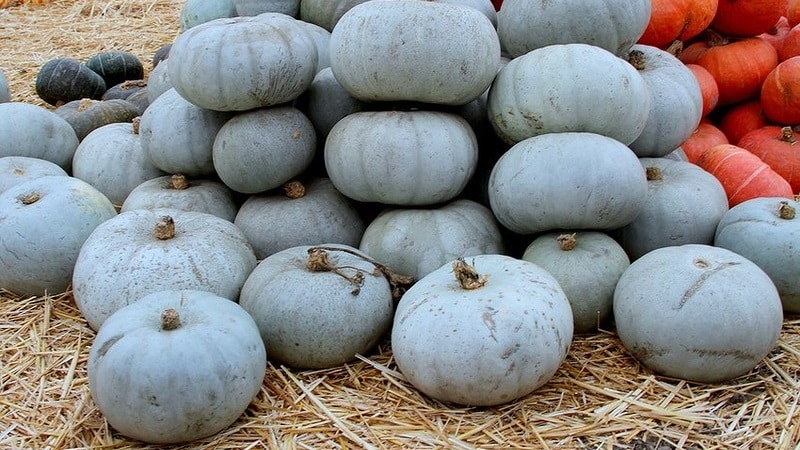
Growing tips from experienced gardeners
Thanks to its excellent taste and ease of care, gray pumpkin is in great demand among gardeners and deserves only positive reviews. If you follow simple but useful tips from experienced gardeners, the process of growing this crop will always be successful even for beginners:
- Before planting, cull the seeds - Dispose of all questionable seeds with signs of mold, disease and mechanical damage. Before sowing, soak the seeds in a solution of potassium permanganate. Only from healthy seed can you get a good harvest.
- You should not plant pumpkins in waterlogged, poor soil with a high level of acidity, because You are unlikely to be able to grow healthy bushes with beautiful and tasty pumpkins. The soil must be loose, enriched with humus and slightly moist.
- The crop area should always be clean. Promptly remove plant debris and weeds, which act as an excellent breeding ground for diseases and parasites.
- Balanced nutrition with nitrogen and phosphorus-potassium preparations will ensure good growth of bushes and further fruiting.
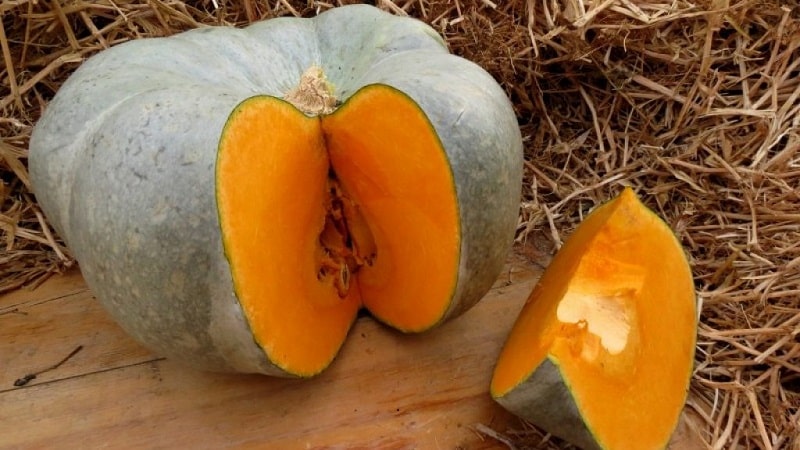
Diseases and pests
The Volga Gray pumpkin has weak immunity to diseases such as:
- powdery mildew;
- gray mold;
- fusarium wilt.
For preventive purposes, it is necessary to use healthy planting material, avoid dense plantings and keep the area clean.
If the plant is damaged, it is treated with fungicides - Bordeaux mixture or copper sulfate.
Irrigation of plantings is carried out a month before the planned harvest. In the fight against gnawing and juice-sucking insects - aphids, spider mites and whiteflies, infusions of tobacco, garlic, onions and hot pepper are used. In case of severe damage, pesticides are used - “Aktellik”, “Fundazol” or “Aktaru”.
Harvest and storage
Volga Gray pumpkin is harvested when it reaches maturity, which is easily identified by its dried stalk. The vegetable can be stored for up to a year. To do this, it is laid on dry straw and the appropriate conditions are created in a well-ventilated room: temperature about +6 degrees and air humidity about 70%.
A ripe vegetable can be stored in an apartment for up to five months.
Advantages and disadvantages of the variety
Advantages:
- high concentration of beta-carotene, iron and potassium;
- low calorie content;
- high content of proteins, iron, zinc, vitamins E and group B, dietary fiber;
- long shelf life.
No deficiencies have been identified in pumpkin, except for some nuances in care: the mandatory formation of the plant and timely watering.
Farmer reviews
Experienced gardeners evaluate the gray pumpkin mostly positively. The variety is actively grown in the vast majority of regions of the country. Opinions of gardeners - further.
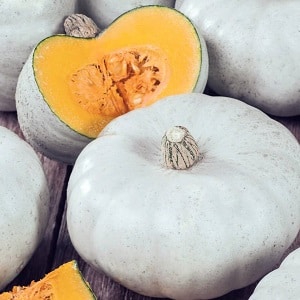 Galina: “For me, the main advantage of a vegetable is its taste. I cook various dishes from it. With minimal costs, you can stock up on harvest for at least six months. Pumpkin is well stored and easily transported over long distances.And caring for it is the same as for a regular variety. I will continue to grow this healthy vegetable.”
Galina: “For me, the main advantage of a vegetable is its taste. I cook various dishes from it. With minimal costs, you can stock up on harvest for at least six months. Pumpkin is well stored and easily transported over long distances.And caring for it is the same as for a regular variety. I will continue to grow this healthy vegetable.”
Arseny: “I’ve been growing gray Volga pumpkin for three years now. In our family, I am the only one who does the gardening, and my wife is in charge of the kitchen. He asks me to grow this kind of pumpkin all the time: it’s the only variety that my grandchildren like. I'm not a fan of this family of vegetables, but my family appreciates pumpkin. I will continue to grow the variety, as it does not cause much trouble. The fruits grow large, as in the photo of the package with seeds.”
Svetlana: “I have been growing Gray Volga pumpkin using seedlings for the third year in a row. I take standard care of it: watering, fertilizing, weeding. In order for the vegetables to grow large, when the fruits are forming, I remove the smallest ones so that all the nutrients go to the remaining pumpkins. I plant the crop in a sunny area of the garden. I make healthy porridge for the children from pumpkin.”
Conclusion
Gray pumpkin does not require much labor when growing. But the benefits of this vegetable can hardly be overestimated. This is a real “gray doctor” who treats diseases of the kidneys, liver, skin, and eyes. Pumpkin is recommended for use by patients with tuberculosis, hypertension, and obesity. This fruit helps make pregnancy easier and slows down the aging process of the body. Large fruits ripen in a timely manner, have excellent taste and are easy to care for during the growing period. The vegetable can be stored for a long time and makes it possible to pamper your household with delicacies all year round.
The following video will help you learn more about growing Volga Gray pumpkin: